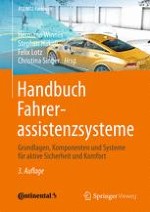2015 | OriginalPaper | Buchkapitel
5. Verhaltenswissenschafltiche Aspekte von Fahrerassistenzsystemen
verfasst von : Bernhard Schlag, Prof. Dr., Gert Weller, Dr. rer. nat.
Erschienen in: Handbuch Fahrerassistenzsysteme
Verlag: Springer Fachmedien Wiesbaden
Aktivieren Sie unsere intelligente Suche, um passende Fachinhalte oder Patente zu finden.
Wählen Sie Textabschnitte aus um mit Künstlicher Intelligenz passenden Patente zu finden. powered by
Markieren Sie Textabschnitte, um KI-gestützt weitere passende Inhalte zu finden. powered by
Zusammenfassung
-
visuelle und kognitive Beanspruchung,
-
Situationsbewusstsein,
-
mentale Modelle.
